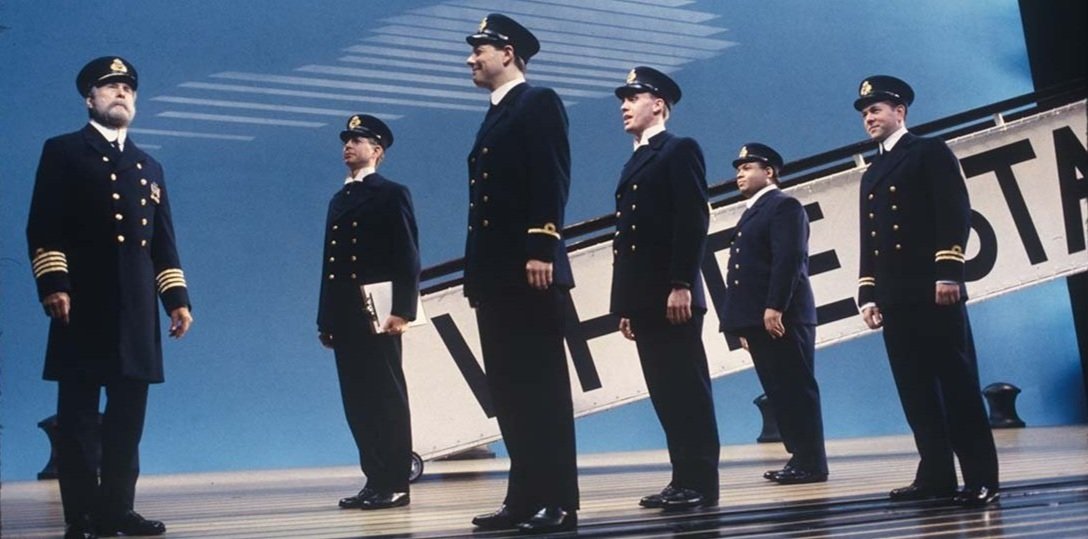
(Just to note: Jack and Rose, who were played by Leonardo DiCaprio and Kate Winslet in James Cameron’s movie about the historical sinking, were not real figures. They were loosely based on the lives of Americans who had no connection to Titanic history. Peter Stone and Maury Yeston opted to create a theatrical work that was more deeply rooted in the sinking’s history.)
Thomas Andrews
In the show:
Mr. Andrews is a shipbuilder with a sweeping vision — to build the largest and fastest passenger vessel that the White Star Line has ever seen. He is presented as the expert on the ship, knowing its ins and outs and every compartment, passenger deck, kitchen and facility that the ship has to offer. He respects the chain of command and defers to the captain. When the Titanic collides with the iceberg, Andrews provides a calm, collected report of the damage. Though Andrews holds part of the blame for the scant number of lifeboats on the ship, it was ultimately the White Star Line’s decision and the lack of broad regulation that meant less than half of the Titanic‘s passengers were rescued.
Near the end of the musical, Andrews sings about his vision behind the ship and laments the flaws that were overlooked as it was manufactured. During this solo, he is shaken from a dreamlike stupor when a Bellboy asks, “Mr. Andrews! Aren’t you going to make a go of it?” Unfortunately, Andrews goes down with the ship.
In real life:
Thomas Andrews was born in February 1873 near Belfast, Ireland and died April 15, 1912 at sea. Born into a wealthy Irish family, he was an Irish shipbuilder best known for designing luxury liners — including the Titanic. His father was the head owner of a shipbuilding firm called Harland and Wolff, where Andrews worked as an apprentice through the early 1890s. Thanks to his expertise and charisma, he became chief of the firm’s design department.
In 1907, the White Star Line, a British shipping company, set plans to create a series of luxury ships. They chose Harland and Wolff for the job. Andrews went on to design both the Olympic and Titanic, which were the largest passenger ships of the early 1900s. The final plans included 16 watertight compartments that could be sealed off from the ships’ bridges — a design which lead White Star to claim the ships as “practically unsinkable.”
Of the Titanic, Andrews once remarked that the ship was “as nearly perfect as human brains can make her.” He, alas, went down with the ship. As it sank, one account claims Andrews was last seen by a steward on the ship, sitting in the first-class smoking room with his arms folded. The steward asked him, “Aren’t you going to have a try for it, Mr. Andrews?” — to which Andrews didn’t answer or move, apparently in a state of shock. The accounts as to what happened in the Titanic’s final moments vary widely, but this particular line was notably included in Yeston and Stone’s musical adaptation.
There is an asteroid named after Andrews. In his time, he was the designer of the largest artificial moving object in the world.
J. Bruce Ismay
In the show:
J. Bruce Ismay is portrayed in the Titanic musical as a proud, demanding businessman — he’s the big boss on the ship. Though he lacks technical knowledge, he abounds with confidence. During the show’s opening number, Ismay calls the ship “the pride of mankind,” and exalts the honor it brings to his name and to the White Star Line. Throughout Titanic, Ismay pushes the crew to run the ship faster — and the lack of caution in his command appears, in the musical, to lead to the ship’s collision with an iceberg. “These days,” Ismay says, “people want speed above everything else.”
When the ship first strikes an iceberg at the top of Titanic‘s second act, Ismay decides not to inform the passengers as to why the vessel has stopped. Ismay reacts with denial at Titanic shipbuilder Andrews’ declaration that the ship is sinking. In the end, Ismay appears with the survivors, wondering why folks assigned blame to him for taking a lifeboat before many women and children.
In real life:
Joseph Bruce Ismay was born near Liverpool in 1862 and died near London in 1937. The British businessman was chairman of the White Star Line and survived the sinking of the Titanic in 1912. He was the eldest son of the line’s former owner, and took up the position as its chairman when his father died. In 1907, he met with the owner of Harland and Wolff, and the two schemed to build a class of large luxury ships that would participate in the highly profitable ferrying of passengers across the Atlantic Ocean.
Ismay was aboard the Titanic‘s maiden voyage, and despite an order that only women and children were allowed in the limited supply of lifeboats, Ismay boarded one. He was the highest-ranking White Star official to survive the sinking. After the sinking, many survivors were rescued by the Carpathia; while Ismay’s reputation had already suffered due to his taking up of a position on the lifeboat, his status further declined due to his actions on the rescue ship.
After being saved, the businessman sent a telegram to the White Star Line which read: “‘Deeply regret advise you Titanic sank this morning fifteenth after collision iceberg, resulting serious loss life further particulars later.’ Bruce Ismay.” After sending this telegram, Ismay reportedly ostracized himself in a private cabin, refusing to leave until the Carpathia docked in New York. Another survivor, Jack Thayer, wrote of Ismay’s stay on the Carpathia: “[Ismay] was staring straight ahead, shaking like a leaf. Even when I spoke to him, he paid absolutely no attention. I have never seen a man so completely wrecked.”
In interviews after the tragic sinking, Ismay faced lengthy questioning, and denied that he had encouraged Captain Edward J. Smith to increase the ship’s speed. In 1913, he stepped down from his position as chairman of the White Star Line. He remained publicly branded as a coward.
Captain Edward J. Smith
In the show:
Captain Edward John Smith serves as the switchboard for the rest of the crew aboard the Titanic. He keeps the ship on course and keeps everyone in line. While the ship is at sea, he determinedly remains at the top of the chain of command — even when the owner, Mr. Ismay, attempts to supercede his authority. He’s a rather domineering captain, scolding his crew members when he feels the boat drifts off course.
As the ship sinks, he reflects on how he’s never seen a shipwreck, nor been on one, in his 40 years at sea. He looks to the heavens for some salvation, and is last seen making an official declaration that the ship is lost.
In real life:
Edward John Smith was born near Staffordshire in England in 1850 and died at sea in April 1912 as the Titanic sank. He began to work on boats as a teenager, and by 1880 he became a junior officer of the White Star Line, commanding his first ship in 1887. On a number of occasions, Smith’s ships ran aground. In 1911, Smith was captain of the Olympic when it collided with the British cruiser Hawke off the Isle of Wight. Despite these gaffs, Smith was very popular among wealthy travelers and became White Star’s senior captain. He once remarked that he could not “imagine any condition which would cause a ship to founder. Modern shipbuilding has gone beyond that.”
Several days into the Titanic‘s maiden voyage, the ship received multiple warnings of icebergs in the sea. Smith responded to these warnings by altering the ships course (in the musical, the Captain seems to do nothing in response to the warning). However, he never reduced the ship’s speed. He was reportedly absent from the bridge when the ship struck an iceberg.
After the collision, he ordered a report of the damage, and Thomas Andrews made the pronouncement that the ship would plunge. Captain Edward Smith went down with the Titanic.
Smith’s commandeering of the Titanic was scrutinized following the tragedy, which lead to ambiguous conclusions. Critics point to the Captain’s pride as the problem — had he failed to decrease speed because he thought he could turn the boat in time to avoid a collision?
Ethel Beane
In the show:
The character of Alice Beane, inspired by the real-life Ethel Beane, is a second-class passenger on the Titanic. Alice serves as a comic element in the show, but the comedy that comes through her dialogue and music is wrapped in truth. Alice feels she must make her way onto the ship as it’s her chance to rub elbows with the high-class people traveling in first class. She is vain, even to the last — in her final moments, as the ship descends, she remarks that she must “fix her face.”
In real life:
Ethel Louisa Beane was born in 1889 in Norfolk, and she passed in 1983 after a long life. She was a second-class passenger on the Titanic and she survived the ship’s sinking. One source suggests Ethel was married just three days before the Titanic sailed, to a Mr. Edward Beane. The couple had made plans to settle in New York.
On the night of the ship’s descent into the sea, the couple managed to escape in lifeboat number 9. This made Edward Beane one of the scarce second-class male passengers who survived. Ethel gave birth to stillborn baby nine months to the day after the sinking, so many speculate that she was pregnant onboard the ship.
Ethel and Edward settled in Rochester, NY and lived there for the rest of their lives. They only spoke about the Titanic every once in a while, and a few newspaper interviews remain of their account of the tragic evening.
Ida Straus
In the show:
Ida Straus first makes an appearance in Titanic the musical when Alice Beane is accounting for all of the first-class passengers as they arrive on the ship. Ida arrives alongside Isidor. Alice sings, “Aren’t they modest? You’d never think by looking at them that he and his brother own Macy’s Department Store.” The couple appears again briefly at the end of the first act, speaking about their son, who wants to make Macy’s the largest retail store in the world.
As the passengers get into the lifeboats, Isidor refuses to board — he’d rather not take the boat before the younger men. He encourages Ida to go, but she refuses. “Refuse? How can you refuse?” he asks her. Ida replies, “I’m sorry, Isidor, but after forty years how can I leave you now?”
Later, amidst the chaos of the sinking ship, Ida and her husband sing a soaring duet about the endurance of their love (“Still”).
In real life:
Rosalie Ida Straus was born in 1849 in Germany and died with her husband Isidor in April 1912 as the Titanic plummeted into the sea. Isidor was the co-owner of the Macy’s department store. The couple had seven children, including the Jesse Isidor Straus referenced in the play, who served as a US Ambassador to France.
Ida’s friends considered her and Isidor to be remarkably close — when Isidor traveled for work, the couple exchanged letters almost daily. They spent the winter of 1911 and 1912 in Europe. The couple had planned to leave England on another passenger ship, but because of a coal strike, fuel was diverted to the Titanic, and they had to take it home.
On the night of the sinking, the couple was seen standing near lifeboat number 8. The officer in charge of the lifeboat welcomed the couple on the lifeboat, but Isidor Straus refused to go while there were women and children still remaining on the ship. He implored his wife to board, but she refused, allegedly saying “We have lived together for many years. Where you go, I go.”
Survivors from lifeboat number 8 and elsewhere told reporters the story of Mrs. Straus’s loyalty, and it plucked the heartstrings of people around the world. Articles about her sacrifice appeared in Yiddish and German newspapers, and her character has been represented in a number of film, television and theatrical retellings of the Titanic tale.
Catherine (Kate) McGowan
In the show:
Kate McGowan, an Irish immigrant, is one of the Titanic musical’s three Kates. In her first appearance, when asked by another third-class passenger if she’s traveling alone, Kate replies by pointing to someone she’s never met and saying that she’s planning to marry him. Later, in the third-class dining room, Kate remarks that her family could live a week off what she’s been leaving untouched on her plate. This second appearance reveals her as someone with a desire to climb upwards; she wants to carve out a space for herself in America.
After the Titanic crashes, the third-class passengers are left with no clear route to the lifeboats. Kate McGowan and the other two Kates sing about how no one on the ship is looking out for the people in their class.
Finally, Kate McGowan appears with the survivors after the foundering of the White Star Line’s pride and joy. The entire company sings about the pride of mankind: Who in their right mind would attempt to build an entire civilization on a ship that’s meant to cross the ocean?
In real life:
Miss Catherine (Kate) McGowan was born in Ireland in 1869, and died at sea in April 1912. She boarded the Titanic with her niece, Anna, whom she was to chaperone to Chicago. Anna survived the sinking.
Catherine, like her many siblings, had left Ireland as a younger woman, settling in the US, at first in Cleveland and later in Chicago. She ran a boarding house there, and was listed on the 1910 census.
Anna McGowan, Catherine’s niece who survived, later recalled the bitter cold of the open Atlantic as she spent time in the rescue boat. She remembered the screams of the people left behind, and said the ship “just busted in half” while it sank. Anna never saw Catherine again — the pair were separated in the confusion of the sinking as crewmen tried to usher as many people as they could into lifeboats.
Catherine’s body, if recovered, was never identified.
To license the musical Titanic, visit Concord Theatricals in the US or UK. Concord Theatricals also licenses an ensemble edition of Titanic, available in the US or UK.

Plays that Inspired Musicals

QUIZ: Which Character from The Lightning Thief Are You?







